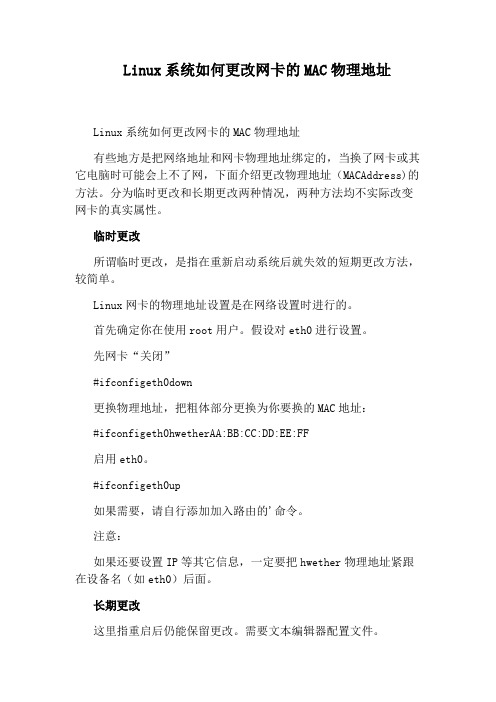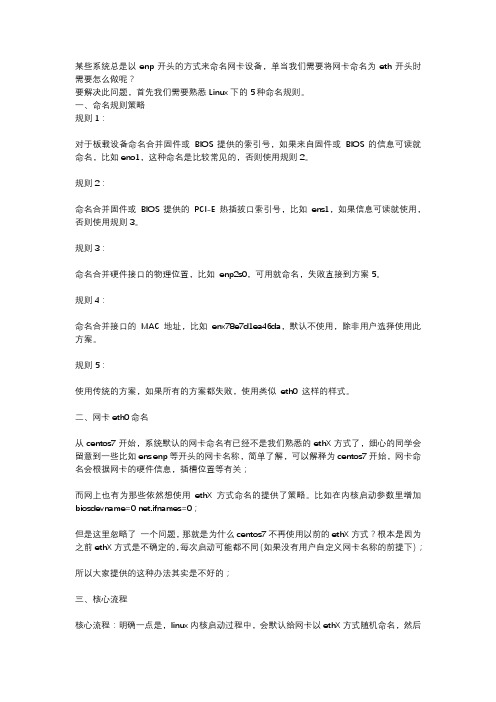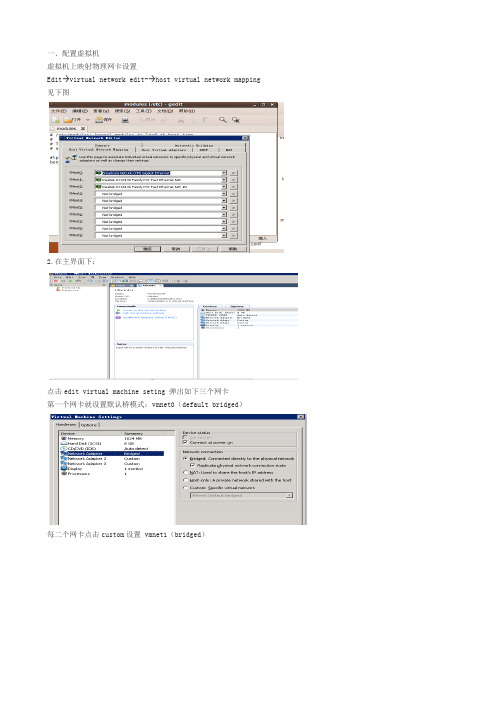深度分析Linux网卡绑定的七种模式
- 格式:doc
- 大小:116.00 KB
- 文档页数:9


Linux系统如何更改网卡的MAC物理地址Linux系统如何更改网卡的MAC物理地址有些地方是把网络地址和网卡物理地址绑定的,当换了网卡或其它电脑时可能会上不了网,下面介绍更改物理地址(MACAddress)的方法。
分为临时更改和长期更改两种情况,两种方法均不实际改变网卡的真实属性。
临时更改所谓临时更改,是指在重新启动系统后就失效的短期更改方法,较简单。
Linux网卡的物理地址设置是在网络设置时进行的。
首先确定你在使用root用户。
假设对eth0进行设置。
先网卡“关闭”#ifconfigeth0down更换物理地址,把粗体部分更换为你要换的MAC地址:#ifconfigeth0hwetherAA:BB:CC:DD:EE:FF启用eth0。
#ifconfigeth0up如果需要,请自行添加加入路由的'命令。
注意:如果还要设置IP等其它信息,一定要把hwether物理地址紧跟在设备名(如eth0)后面。
长期更改这里指重启后仍能保留更改。
需要文本编辑器配置文件。
Debian(Ubuntu很可能也在此列)编辑/etc/network/interfaces,找到与eth0有关的地方,修改到形如:allow-hotplugeth0ifaceeth0inetdhcp#ifaceeth0inetstatic#address1.1.1.6#netmask255.255.255.0#gateway1.1.1.1hwaddressether00:AA:BB:CC:DD:EE注释的部分是静态IP的写法,当前的未注释的是动态IP的写法。
详细信息请参见Debian网络设置Archlinux或Gentoo编辑/etc/rc.conf(Archlinux)或/etc/conf.d/net(Gentoo),在eth0配置的字符串中,在IP地址的前面加入hwether00:AA:BB:CC:DD:EE。
Gentoo和Archlinux的网络设置,请参阅发行版的相关文档。

Linux负载均衡一、LVS概述及原理LVS是一个开源的软件,由毕业于国防科技大学的章文嵩博士于1998年5月创立,可以实现LINUX平台下的简单负载均衡。
LVS是Linux Virtual Server的缩写,意思是Linux虚拟服务器。
LVS集群采用IP负载均衡技术和基于内容请求分发技术。
调度器具有很好的吞吐率,将请求均衡地转移到不同的服务器上执行,且调度器自动屏蔽掉服务器的故障,从而将一组服务器构成一个高性能的、高可用的虚拟服务器。
整个服务器集群的结构对客户是透明的,而且无需修改客户端和服务器端的程序。
为此,在设计时需要考虑系统的透明性、可伸缩性、高可用性和易管理性。
一般来说,LVS集群采用三层结构,其主要组成部分为:1) 负载调度器(load balancer),它是整个集群对外面的前端机,负责将客户的请求发送到一组服务器上执行,而客户认为服务是来自一个IP地址(我们可称之为虚拟IP地址)上的。
2) 服务器池(server pool),是一组真正执行客户请求的服务器,执行的服务有WEB、MAIL、FTP和DNS等。
3) 共享存储(shared storage),它为服务器池提供一个共享的存储区,这样很容易使得服务器池拥有相同的内容,提供相同的服务。
调度器是服务器集群系统的唯一入口点(Single Entry Point),它可以采用IP 负载均衡技术、基于内容请求分发技术或者两者相结合。
在IP负载均衡技术中,需要服务器池拥有相同的内容提供相同的服务。
当客户请求到达时,调度器只根据服务器负载情况和设定的调度算法从服务器池中选出一个服务器,将该请求转发到选出的服务器,并记录这个调度;当这个请求的其他报文到达,也会被转发到前面选出的服务器。
在基于内容请求分发技术中,服务器可以提供不同的服务,当客户请求到达时,调度器可根据请求的内容选择服务器执行请求。
因为所有的操作都是在Linux操作系统核心空间中将完成的,它的调度开销很小,所以它具有很高的吞吐率。


active-backup原理
Active-Backup是Linux内核中的一种网络绑定模式,它被设计用于提高网络的可用性和可靠性。
它结合了多个物理网卡,并将它们看做是一个虚拟接口,从而提供了一个冗余的网络连接方式。
当一个网卡故障时,Active-Backup会自动切换到其他可用的网卡,以保持网络通信的连续性和稳定性。
Active-Backup的工作原理如下:系统会将多个网卡绑定在一起,并将它们组成一个虚拟的接口,称之为绑定接口。
当数据包要发送到外部网络时,它们首先会被发送到绑定接口,然后由绑定接口将数据包转发到其中一个物理网卡上。
这个时候,这个网卡被视为active网卡,而其他网卡则被称为backup网卡。
active 网卡负责发送和接收数据包,而backup网卡则处于备份状态,等待被激活。
如果active网卡故障,绑定接口会自动切换到backup网卡上,以保证数据包的正常传输。
此外,绑定接口还支持负载均衡的功能。
在负载均衡模式下,数据包的发送会均衡地分配到所有的网卡上,从而提高了网络的带宽利用率。
总之,Active-Backup是一种提高网络可用性和可靠性的技术,它通过将多个网卡绑定在一起,实现了冗余备份和负载均衡的功能。
它可以应用于各种网络环境中,如企业网络、数据中心、云计算等。

一、配置虚拟机虚拟机上映射物理网卡设置Edit→virtual network edit-→host virtual network mapping 见下图2.在主界面下:点击edit virtual machine seting 弹出如下三个网卡第一个网卡就设置默认桥模式:vmnet0(default bridged)每二个网卡点击custom设置 vmnet1(bridged)每三个网卡点击custom设置 vmnet2(bridged)二、配置双网卡做lacp∙mode=0 (balance-rr): 採取依序使用的連線的方式,提供了負載均衡及容錯的功能λ∙mode=1 (active-backup): 眾多的連線中,只有一個是啟用的狀態,當啟用的連線失效(敗),則由備援的連線接手,提供容錯機制λ∙mode=2 (balance-xor): 採用xor的演算法來選擇傳輸的連線,其結果是以目的地MAC為基準選擇哪一條連線;提供了負載均衡及容錯機制λ∙mode=3 ( broadcast): 把封包送到所有的連線,當有連線失效沒有任何downtime,但此法過於浪費連線資源;有容錯機制λ∙mode=4 (802.3ad, LACP): IEEE 802.3ad Dynamic Link Aggregation協定;提供較好的機制,並可搭配802.1Q trunking同時介接不同的VLAN;惟獨此法必須與支援802.3ad的交換機介接,並且每個slave的驅動程式都需支援ethtool擷取介面的訊息, 較為豪華,但是提供了相當優良的應用,負載均衡及容錯機制λ∙mode=5 (balance-tlb): Adaptive Transmit load balancing; 無須交換機支援但slave驅動程式需支援ethtool;根據連線介面卡的負載決定traffic如何送出,回覆的traffic則由送出的salve接收λ∙mode=6 (balance-alb): 包含了mode 5所有功能及需求,再加上接收traffic時的負載均衡.编辑/etc/network/interfacesauto lo bond0 eth3 eth4iface bond0 inet staticaddress 1.1.1.2netmask 255.255.255.0network 1.1.1.0gateway 1.1.1.1up /sbin/ifenslave bond0 eth3up /sbin/ifenslave bond0 eth4iface lo loopbackiface eth3 inet staticaddress 1.1.2.4netmask 255.255.255.0iface eth4 inet staticaddress 1.1.2.5netmask 255.255.255.0再编辑 /etc/modprobe.configalias bond0 bondingoptions bonding mode=4 miimon=100接着:/etc/modulesbonding mode=4 miimon=100最后重启网络即可/etc/init.d/networking restart注:最好重启一下系统Linux下的绑定状态:root@qinyb-vmubuntu:~/下载# cat /proc/net/bonding/bond0Ethernet Channel Bonding Driver: v3.5.0 (November 4, 2008)Bonding Mode: load balancing (round-robin)MII Status: upMII Polling Interval (ms): 100Up Delay (ms): 0Down Delay (ms): 0Slave Interface: eth3MII Status: upLink Failure Count: 0Permanent HW addr: 00:0c:29:72:71:12Slave Interface: eth4MII Status: upLink Failure Count: 0Permanent HW addr: 00:0c:29:72:71:1c接口配置信息:root@qinyb-vmubuntu:~/下载# ifconfigbond0 Link encap:以太网硬件地址 00:0c:29:72:71:12inet 地址:1.1.1.2 广播:1.1.1.255 掩码:255.255.255.0inet6 地址: fe80::20c:29ff:fe72:7112/64 Scope:LinkUP BROADCAST RUNNING MASTER MULTICAST MTU:1500 跃点数:1 接收数据包:395 错误:0 丢弃:0 过载:0 帧数:0发送数据包:1724 错误:0 丢弃:0 过载:0 载波:0碰撞:0 发送队列长度:0接收字节:56440 (56.4 KB) 发送字节:152556 (152.5 KB)eth2 Link encap:以太网硬件地址 00:0c:29:72:71:08inet 地址:192.168.181.4 广播:192.168.181.255 掩码:255.255.255.0 inet6 地址: fe80::20c:29ff:fe72:7108/64 Scope:LinkUP BROADCAST RUNNING MULTICAST MTU:1500 跃点数:1接收数据包:52500 错误:0 丢弃:0 过载:0 帧数:0发送数据包:30026 错误:0 丢弃:0 过载:0 载波:0碰撞:0 发送队列长度:1000接收字节:49586740 (49.5 MB) 发送字节:2592952 (2.5 MB)中断:18 基本地址:0x2000eth3 Link encap:以太网硬件地址 00:0c:29:72:71:12inet 地址:1.1.2.4 广播:1.1.2.255 掩码:255.255.255.0UP BROADCAST RUNNING SLAVE MULTICAST MTU:1500 跃点数:1 接收数据包:205 错误:0 丢弃:0 过载:0 帧数:0发送数据包:891 错误:0 丢弃:0 过载:0 载波:0碰撞:0 发送队列长度:1000接收字节:39490 (39.4 KB) 发送字节:80263 (80.2 KB)中断:16 基本地址:0x2080eth4 Link encap:以太网硬件地址 00:0c:29:72:71:12inet 地址:1.1.2.5 广播:1.1.2.255 掩码:255.255.255.0UP BROADCAST RUNNING SLAVE MULTICAST MTU:1500 跃点数:1 接收数据包:190 错误:0 丢弃:0 过载:0 帧数:0发送数据包:833 错误:0 丢弃:0 过载:0 载波:0碰撞:0 发送队列长度:1000接收字节:16950 (16.9 KB) 发送字节:72293 (72.2 KB)中断:17 基本地址:0x2400lo Link encap:本地环回inet 地址:127.0.0.1 掩码:255.0.0.0inet6 地址: ::1/128 Scope:HostUP LOOPBACK RUNNING MTU:16436 跃点数:1接收数据包:899 错误:0 丢弃:0 过载:0 帧数:0发送数据包:899 错误:0 丢弃:0 过载:0 载波:0碰撞:0 发送队列长度:0接收字节:97324 (97.3 KB) 发送字节:97324 (97.3 KB)Eth2 连外网没有参与绑定。
《Linux网络操作系统项目教程(RHEL7、4/CentOS 7、4)(第3版)》课后习题答案1、11练习题一、填空题1.GNU得含义就是。
2。
Linux一般有3个主要部分:、、。
3。
目前被称为纯种得UNIX指得就就是以及这两套操作系统。
4.Linux就是基于得软件模式进行发布得,它就是GNU项目制定得通用公共许可证,英文就是。
5.史托曼成立了自由软件基金会,它得英文就是.6.POSIX就是得缩写,重点在规范核心与应用程序之间得接口,这就是由美国电气与电子工程师学会(IEEE)所发布得一项标准.7.当前得Linux常见得应用可分为与两个方面。
8.Linux得版本分为与两种。
9。
安装Linux最少需要两个分区,分别就是。
101、一个自由软件组织)2、内核(kernel)、命令解释层(Shell或其她操作环境)、实用工具3、System VBSD4、Copyleft(无版权)General PublicLicense,GPL)5、FSF,FreeSoftware Foundation6、便携式操作系统接口(Portable Operating System Interface)7、企业应用个人应用8、内核版本发行版本9、swap交换分区/(根)分区10、root二、选择题1.Linux最早就是由计算机爱好者()开发得。
A.Richard Petersen ﻩﻩB.Linus TorvaldsﻩC。
Rob Pick ﻩﻩﻩD.Linux Sarwar2。
下列中()就是自由软件。
A。
Windows XPﻩB。
UNIX C.Linux D.Windows20083。
下列中( )不就是Linux得特点。
A.多任务ﻩB.单用户C。
设备独立性D.开放性4.Linux得内核版本2、3、20就是( )得版本。
A。
不稳定B。
稳定得ﻩC.第三次修订ﻩﻩD.第二次修订5.Linux安装过程中得硬盘分区工具就是()。
A.PQmagicﻩﻩB.FDISKﻩﻩC。
《网络服务器搭建、配置与管理-Linux版(第3版)》1.11 练习题一、填空题1.GNU的含义是。
2.Linux一般有3个主要部分:、、。
3.目前被称为纯种的UNIX指的就是以及这两套操作系统。
4.Linux是基于的软件模式进行发布的,它是GNU项目制定的通用公共许可证,英文是。
5.史托曼成立了自由软件基金会,它的英文是。
6.POSIX是的缩写,重点在规范核心与应用程序之间的接口,这是由美国电气与电子工程师学会(IEEE)所发布的一项标准。
7.当前的Linux常见的应用可分为与两个方面。
8.Linux的版本分为和两种。
9.安装Linux最少需要两个分区,分别是。
10.Linux默认的系统管理员账号是。
二、选择题1.Linux最早是由计算机爱好者()开发的。
A.Richard Petersen B.Linus TorvaldsC.Rob Pick D.Linux Sarwar2.下列中()是自由软件。
A.Windows XP B.UNIX C.Linux D.Windows 2008 3.下列中()不是Linux的特点。
A.多任务B.单用户C.设备独立性D.开放性4.Linux的内核版本2.3.20是()的版本。
A.不稳定B.稳定的C.第三次修订D.第二次修订5.Linux安装过程中的硬盘分区工具是()。
A.PQmagic B.FDISK C.FIPS D.Disk Druid 6.Linux的根分区系统类型可以设置成()。
A.FATl6 B.FAT32 C.ext4 D.NTFS三、简答题1.简述Linux的体系结构。
2.使用虚拟机安装Linux系统时,为什么要先选择稍后安装操作系统,而不是去选择RHEL 7系统镜像光盘?3.简述RPM与Yum软件仓库的作用。
4.安装Red Hat Linux系统的基本磁盘分区有哪些?5.Red Hat Linux系统支持的文件类型有哪些?6.丢失root口令如何解决?7.RHEL 7系统采用了systemd作为初始化进程,那么如何查看某个服务的运行状态?2.6 练习题一、填空题1.文件主要用于设置基本的网络配置,包括主机名称、网关等。
《Linux网络操作系统项目教程(RHEL7、4/CentOS 7、4)(第3版)》课后习题答案1、11 练习题一、填空题1.GNU的含义就是。
2.Linux一般有3个主要部分:、、。
3.目前被称为纯种的UNIX指的就就是以及这两套操作系统。
4.Linux就是基于的软件模式进行发布的,它就是GNU项目制定的通用公共许可证,英文就是。
5.史托曼成立了自由软件基金会,它的英文就是。
6.POSIX就是的缩写,重点在规范核心与应用程序之间的接口,这就是由美国电气与电子工程师学会(IEEE)所发布的一项标准。
7.当前的Linux常见的应用可分为与两个方面。
8.Linux的版本分为与两种。
9.安装Linux最少需要两个分区,分别就是。
10.Linux默认的系统管理员账号就是。
1、GNU's Not Unix的递归缩写(GNU计划一个自由软件组织)2、内核(kernel)、命令解释层(Shell或其她操作环境)、实用工具3、System V BSD4、Copyleft(无版权) General Public License,GPL)5、FSF,Free Software Foundation6、便携式操作系统接口(Portable Operating System Interface)7、企业应用个人应用8、内核版本发行版本9、swap交换分区/(根)分区10、root二、选择题1.Linux最早就是由计算机爱好者( )开发的。
A.Richard PetersenB.Linus TorvaldsC.Rob PickD.Linux Sarwar2.下列中( )就是自由软件。
A.Windows XPB.UNIXC.LinuxD.Windows 20083.下列中( )不就是Linux的特点。
A.多任务B.单用户C.设备独立性D.开放性4.Linux的内核版本2、3、20就是( )的版本。
A.不稳定B.稳定的C.第三次修订D.第二次修订5.Linux安装过程中的硬盘分区工具就是( )。
深度分析Linux下双网卡绑定七种模式现在一般的企业都会使用双网卡接入,这样既能添加网络带宽,同时又能做相应的冗余,可以说是好处多多。
而一般企业都会使用linux操作系统下自带的网卡绑定模式,当然现在网卡产商也会出一些针对windows操作系统网卡管理软件来做网卡绑定(windows操作系统没有网卡绑定功能需要第三方支持)。
进入正题,linux有七种网卡绑定模式:Mode=0:round robinMode=1:active-backupMode=2:load balancing (xor)Mode=3:fault-tolerance (broadcast)Mode=4:lacpMode=5:transmit load balancingMode=6:adaptive load balancing第一种:bond0:round robin标准:round-robin policy: Transmit packets in sequential order from the first available slave through the last. This mode provides load balancing and fault tolerance.特点:(1)所有链路处于负载均衡状态,轮询方式往每条链路发送报文,基于per packet方式发送。
服务上ping 一个相同地址:1.1.1.1 双网卡的两个网卡都有流量发出。
负载到两条链路上,说明是基于per packet方式,进行轮询发送。
(2)这模式的特点增加了带宽,同时支持容错能力,当有链路出问题,会把流量切换到正常的链路上。
实际绑定结果:cat /proc/net/bonding/bond0Ethernet Channel Bonding Driver: v3.6.0 (September 26, 2009)Bonding Mode: load balancing (round-robin)-----RR的模式MII Status: upMII Polling Interval (ms): 100Up Delay (ms): 0Down Delay (ms): 0Slave Interface: eth0MII Status: upLink Failure Count: 0Permanent HW addr: 74:ea:3a:6a:54:e3Slave Interface: eth1MII Status: upLink Failure Count: 0应用拓扑:交换机端需要配置聚合口,cisco叫port channel。
拓扑图如下:第二种:bond1:active-backup标准文档定义:Active-backup policy: Only one slave in the bond is active. A different slave becomes active if, and only if, the active slave fails. The bond’s MAC address is externally visible on only one port (network adapter) to avoid confusing the switch. This mode provides fault tolerance. The primary option affects the behavior of this mode.模式的特点:一个端口处于主状态,一个处于从状态,所有流量都在主链路上处理,从不会有任何流量。
当主端口down掉时,从端口接手主状态。
实际绑定结果:root@1:~# cat /proc/net/bonding/bond0Ethernet Channel Bonding Driver: v3.6.0 (September 26, 2009)Bonding Mode: fault-tolerance (active-backup) —–backup模式Primary Slave: NoneCurrently Active Slave: eth0MII Status: upMII Polling Interval (ms): 100Up Delay (ms): 0Down Delay (ms): 0Slave Interface: eth0MII Status: upLink Failure Count: 0Permanent HW addr: 74:ea:3a:6a:54:e3Slave Interface: eth1Link Failure Count: 0Permanent HW addr: d8:5d:4c:71:f9:94应用拓扑:这种模式接入不需要交换机端支持,随便怎么接入都行。
第三种:bond2:load balancing (xor)标准文档描述:XOR policy: Transmit based on [(source MAC address XOR'd with destination MAC address) modulo slave count]. This selects the same slave for each destination MAC address. This mode provides load balancing and fault tolerance.特点:该模式将限定流量,以保证到达特定对端的流量总是从同一个接口上发出。
既然目的地是通过MAC地址来决定的,因此该模式在―本地‖网络配置下可以工作得很好。
如果所有流量是通过单个路由器(比如―网关‖型网络配置,只有一个网关时,源和目标mac都固定了,那么这个算法算出的线路就一直是同一条,那么这种模式就没有多少意义了。
),那该模式就不是最好的选择。
和balance-rr一样,交换机端口需要能配置为―port channel‖。
这模式是通过源和目标mac做hash因子来做xor算法来选路的。
实际绑定结果:[root@localhost ~]# cat /proc/net/bonding/bond0Ethernet Channel Bonding Driver: v3.0.3 (March 23, 2006)Bonding Mode: load balancing (xor) ——配置为xor模式Transmit Hash Policy: layer2 (0)MII Status: upMII Polling Interval (ms): 100Up Delay (ms): 0Down Delay (ms): 0Slave Interface: eth1MII Status: upLink Failure Count: 0Permanent HW addr: 00:d0:f8:40:f1:a0Slave Interface: eth2MII Status: upLink Failure Count: 0Permanent HW addr: 00:d0:f8:00:0c:0c应用拓扑:同bond0一样的应用模型。
这个模式也需要交换机配置聚合口。
第四种:bond3:fault-tolerance (broadcast)标准文档定义:Broadcast policy: transmits everything on all slave interfaces. This mode provides fault tolerance.特点:这种模式的特点是一个报文会复制两份往bond下的两个接口分别发送出去,当有对端交换机失效,我们感觉不到任何downtime,但此法过于浪费资源;不过这种模式有很好的容错机制。
此模式适用于金融行业,因为他们需要高可靠性的网络,不允许出现任何问题。
root@ubuntu12:~/ram# cat /proc/net/bonding/bond0Ethernet Channel Bonding Driver: v3.6.0 (September 26, 2009)Bonding Mode: fault-tolerance (broadcast) ——- fault-tolerance 模式MII Status: upMII Polling Interval (ms): 100Up Delay (ms): 0Down Delay (ms): 0Slave Interface: eth0MII Status: upLink Failure Count: 0Permanent HW addr: 74:ea:3a:6a:54:e3Slave Interface: eth1MII Status: upLink Failure Count: 0Permanent HW addr: d8:5d:4c:71:f9:94应用拓扑:如下:这种模式适用于如下拓扑,两个接口分别接入两台交换机,并且属于不同的vlan,当一边的网络出现故障不会影响服务器另一边接入的网络正常工作。
而且故障过程是0丢包。
下面展示了这种模式下ping信息:64 bytes from 1.1.1.1: icmp_seq=901 ttl=64 time=0.205 ms64 bytes from 1.1.1.1: icmp_seq=901 ttl=64 time=0.213 ms (DUP!) —dup为重复报文64 bytes from 1.1.1.1: icmp_seq=902 ttl=64 time=0.245 ms64 bytes from 1.1.1.1: icmp_seq=902 ttl=64 time=0.254 ms (DUP!)64 bytes from 1.1.1.1: icmp_seq=903 ttl=64 time=0.216 ms64 bytes from 1.1.1.1: icmp_seq=903 ttl=64 time=0.226 ms (DUP!)从这个ping信息可以看到,这种模式的特点是,同一个报文服务器会复制两份分别往两条线路发送,导致回复两份重复报文,这种模式有浪费资源的嫌疑。
第五种:bond4:lacp标准文档定义:IEEE 802.3ad Dynamic link aggregation. Creates aggregation groups that share the same speed and duplex settings. Utilizes all slaves in the active aggregator according to the 802.3ad specification. Pre-requisites: 1. Ethtool support in the base drivers for retrieving.the speed and duplex of each slave. 2. A switch that supports IEEE 802.3ad Dynamic linkaggregation. Most switches will require some type of configuration to enable 802.3ad mode.特点:802.3ad模式是IEEE标准,因此所有实现了802.3ad的对端都可以很好的互操作。